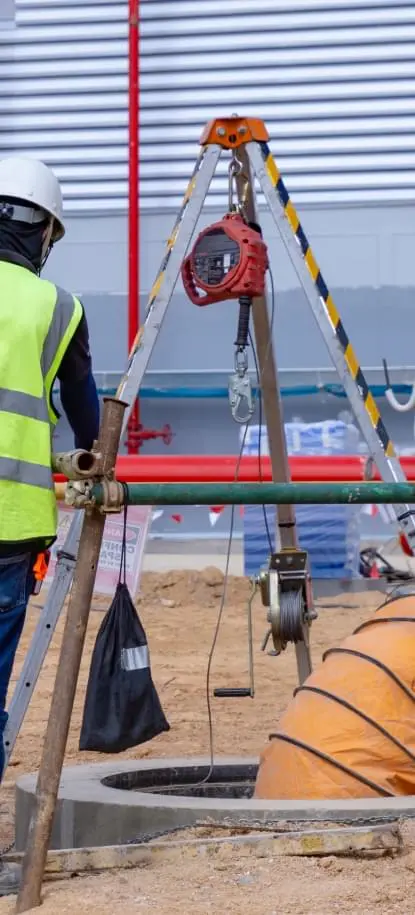




Quick Links:





The Confined Space Entry Program standardizes the requirements regarding the permit process, confined space training, and work practices to ensure safe entry into the confined space. It is also intended to protect all individuals from the hazards of entry into Confined Spaces by limiting access to authorized individuals and by defining controls necessary to eliminate or mitigate all hazards when entering Confined Spaces.
A Confined Space is defined as any area that is not intended for human occupancy, except to perform work, and that also has the potential to contain a dangerous atmosphere.
A Confined Space is defined as any area, fully or partially enclosed, that is not intended for human occupancy, except for the purposes of performing work, and that also has the potential for containing dangerous atmosphere. A Confined Space is:
An area that could result in asphyxiation or being trapped by anyone who enters.
An area that has a restricted means of entry and exit.
An area which may become hazardous to any person entering it owing to its design, construction, location or atmosphere, the materials or substances in it, or any other conditions relating to it.
Examples of confined spaces include, but are not limited to, tanks, sewers, communication vaults, valve boxes, trenches, ducting, interstitial roof, etc.
The identification must be based on the definition of Confined Spaces, as per the Confined Space evaluation and risk assessment. Refer to the below Confined Space Identification and control flowchart:
A Confined Space, which after evaluation, is found to contain actual or potential serious hazards. Because of the severity of the hazards, the confined space requires written authorization for entry (Confined Space Entry Work Permit).
A space that by configuration meets the definition of a Confined Space, but which after evaluation presents no potential or existing serious hazards to the Entrants, or has the serious hazards removed by engineering controls. Non-permit confined spaces must be evaluated when changes occur in their use or configuration and, where appropriate, must be reclassified as Permit Required Confined Spaces, including when entry is required to eliminate hazards and obtain data.
Specific safe working procedure/plan SWP must be developed for the NPCS entry and every year, or whenever there is a change in the confined space environment, the SWP must be reviewed/updated. Only long-term service providers are subject to this section.
All Confined Spaces must be recorded in the Confined Spaces Register. Each department will be responsible for the maintenance of the Confined Space Register. The confined spaces register shall be reviewed annually or whenever there is a change in the confined spaces. The Confined Spaces Register must contain the following information as a minimum:
Confined Space entry team members must be trained in their roles and mandatory training requirements needed to accomplish the mission of entering, working, and exiting the space safely. It is the responsibility of the employer to ensure the following team members must receive a full practical confined space entry training to acquire the knowledge, skills, and abilities to function as a Confined Space Entry Team: Entry Supervisor, Entrant(s), Attendant(s), Atmospheric Tester, and Rescue Personnel. Each in-house team member must have a certification documenting training. This also includes in-house rescue personnel. Entry team members must receive KAUST HSE annual refresher training as follows:
The ownership of the Confined Space lies with the user department, and they will be responsible to identify all Confined Spaces that employees may need to enter. The identification must be based on the definition of Confined Spaces, as per the Confined Space evaluation and risk assessment. Refer to section 5.1 of the SOP Confined Space Entry and Gas Testing for further details.
No. Only long-term service providers/contractors are subject to this section 5.3.
The user department shall develop and implement a safe working procedure/plan (SWP) for entry into NPCS and what conditions and precautions must be in place to allow for safe entry and what would constitute a change in conditions, which would require a re-evaluation of the confined space. Specific SWP must be developed for the NPCS entry and every year, or whenever there is a change in the confined space environment, the SWP must be reviewed/updated. The SWP must be reviewed and approved by the department’s manager/head first, then to be submitted to KAUST HSE for review and approval. Refer to section 5.3 of the SOP Confined Space Entry and Gas Testing for further details.
Work Permits are administrated using the HSE web-based safety management system. The Receiver requests the Work Permit from the Issuer and provides the information for their assigned activity. The issuer will review and add any additional precautionary measures and request work permit in Salute through Safe Working Authorization (SWA). The Issuer will fill out all the details about the activities agreed upon with the Receiver and upload all relevant documents related to the activity. visit the Work Permit Program on the HSE website for more information.
No. Entry team members must receive KAUST HSE annual refresher training as follows:
Annually
It is the responsibility of the employer to ensure the following team members must receive a full practical confined space entry training to acquire the knowledge, skills, and abilities to function as a Confined Space Entry Team: Entry Supervisor, Entrant(s), Attendant(s), Atmospheric Tester, and Rescue Personnel. Each in-house team member must have a certification documenting training. Entry team members must receive KAUST HSE annual refresher training following completion of full practical confined space entry training, complete a theory based Confined Space refresher training course in Salute.
Visit SALUTE LMS and search for the Confined Space Entry and Gas Testing Procedure Training. Contact: hse@kaust.edu.sa for more information.
It is an online training via SALUTE LMS.
